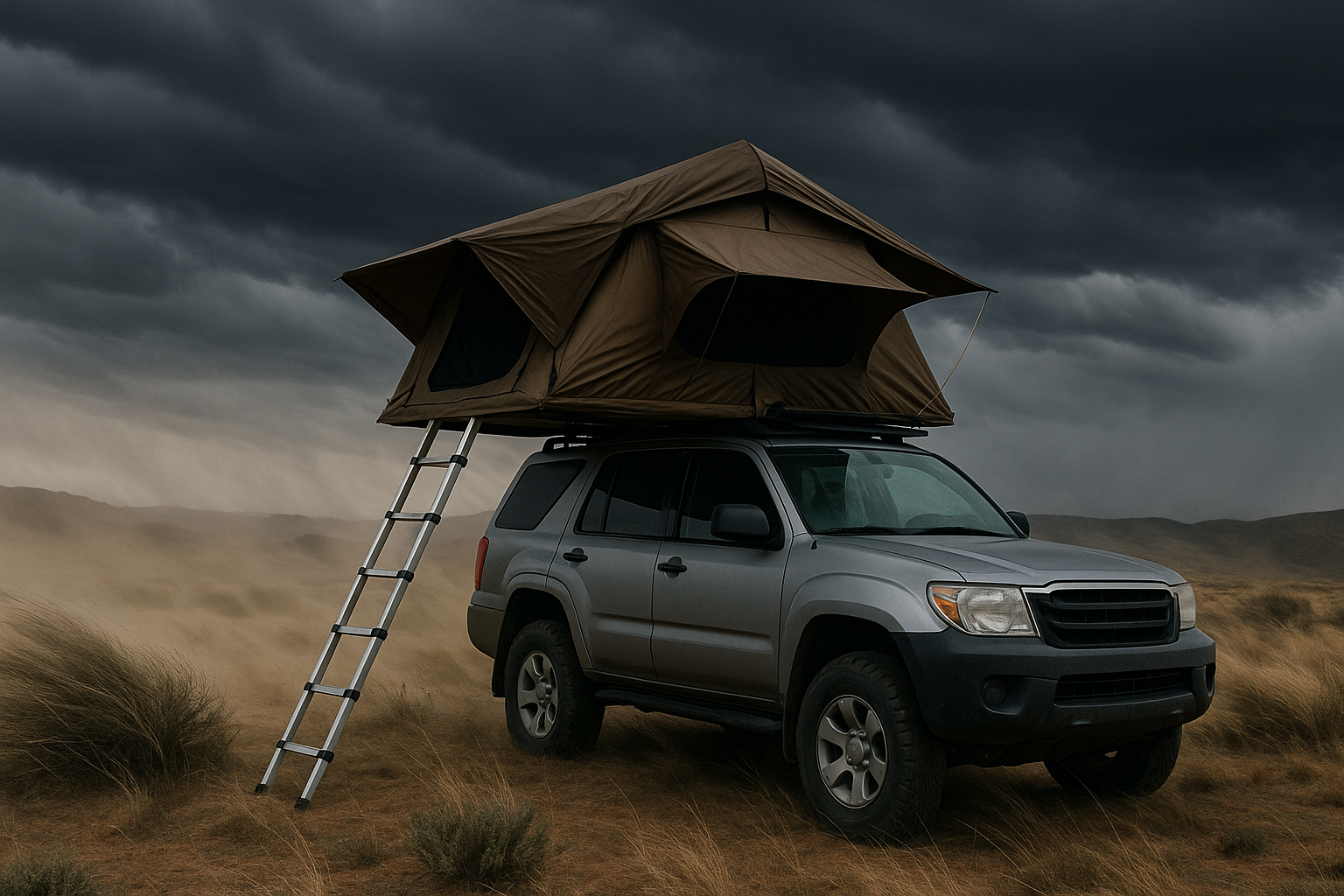The wind’s howling, trees are bending, and your rooftop tent starts shaking like it’s about to take flight. Whether you’re camping on a windswept ridge or facing a surprise storm in the backcountry, high winds aren’t just an annoyance—they’re a real threat to your shelter and safety. But don’t panic. You don’t need specialized gear or a complete campsite overhaul. Here’s how to rig your rooftop tent to withstand high gusts, using tactics that are field-tested, reliable, and built on a survival mindset.
1️⃣ Position Strategically: Play the Angles, Not the Odds
Before you even set up:
- Scout for natural windbreaks—dense trees, boulders, or terrain features like ridges.
- Orient your rooftop tent’s narrow side into the wind, reducing surface area exposed to gusts.
- Avoid parking broadside to the wind; even slight angling helps deflect force.
🛠 Why it works: Minimizing surface area exposed to wind reduces drag and lessens strain on tent poles and fabric.
2️⃣ Use Your Vehicle as a Shield
Leverage your car’s bulk to your advantage:
- Park the vehicle with its broad side facing the wind, creating a natural windbreak for your rooftop tent.
- Angle slightly if necessary to direct gusts over or around the tent.
- Position close to natural features like shrubs or low ridges for added shelter.
🛠 Why it works: Combining your vehicle with natural elements creates a multi-layered barrier against wind.
3️⃣ Stake Guy Lines to the Max
Rooftop tents often come with guy points—but many campers ignore them. In high winds:
- Use all available guy points, even the less obvious ones.
- Anchor with heavy-duty stakes—improvise with rebar, rocks, or logs if necessary.
- Angle guy lines downward at 45°, maximizing tension and stability.
- Cross-tension guy lines where possible, creating a web of support.
🛠 Why it works: Properly anchored guy lines distribute wind load, stabilizing the tent and reducing strain on poles.
4️⃣ Reinforce the Ladder
The ladder isn’t just for access—it’s a structural stabilizer:
- Position it firmly against solid ground, not on sand or loose gravel.
- Secure it with extra straps or rope, tying it to the vehicle or nearby objects.
- If needed, wedge rocks or logs around the ladder base for added stability.
🛠 Why it works: A stable ladder anchors the tent, reducing sway and minimizing pole stress.
5️⃣ Fabric Tension Control: Don’t Over-Tighten
Many campers instinctively pull their tent fabric as tight as possible—but this can backfire in wind:
- Leave a little give in fabric tension, allowing it to flex and absorb gusts.
- Reinforce stress points with extra loops of cord or straps to distribute load.
- Check and adjust tension as wind direction changes.
🛠 Why it works: Slight fabric flexibility prevents sudden rips or seam failures in strong gusts.
6️⃣ Add Low-Profile Weight
Wind gets under tents and lifts them—combat this by:
- Placing heavy gear or water containers inside the tent’s base, anchoring it from within.
- Tie sandbags or filled dry bags to corner poles or ladder points.
- Secure roof racks tightly to reduce lift.
🛠 Why it works: Extra weight lowers the tent’s center of gravity and resists uplift.
7️⃣ Field-Built Wind Barriers
If natural cover is lacking:
- Use spare tarps, blankets, or even trash bags to create a makeshift wind barrier.
- Secure with rocks, logs, or stakes, forming a wall on the wind-facing side.
- Stack firewood or gear boxes strategically to block lower-level wind.
🛠 Why it works: Physical barriers disrupt wind flow and reduce force against the tent.
8️⃣ Check and Reinforce All Connections
Wind exposes every weak point:
- Inspect all tent connections—zippers, poles, guy lines, ladder joints—before wind hits.
- Wrap duct tape or cord around stress points to prevent slippage.
- Double-check car rack tightness, especially if it’s a modular system.
🛠 Why it works: Reinforcing weak spots reduces catastrophic failure risk during high gusts.
9️⃣ Quick-Release Tactics: Be Ready to Drop
In extreme wind situations:
- Pre-plan a rapid takedown method, securing cords in a way that allows you to release pressure quickly.
- Loosen front guy lines first, then drop the ladder to collapse the tent onto the vehicle.
- Tie the tent securely to the vehicle in its collapsed form to prevent damage.
🛠 Why it works: Being prepared to drop the tent prevents total loss or damage if conditions worsen suddenly.
Real-World Camper Tips:
🔹 “I always use my vehicle as a windbreak—it’s saved my setup in sudden squalls.”
🔹 “Extra guy lines and water jugs tied to the tent base made the difference during 50 mph winds.”
🔹 “I leave the fabric slightly loose and check every tie-down when the wind shifts direction.”
Conclusion:
Wind can turn your rooftop tent from a cozy refuge into a liability—but it doesn’t have to. With strategic setup, reinforced anchor points, and the right mindset, you can withstand high gusts and keep your shelter safe. Whether it’s positioning your tent, using the car as a windbreak, or rigging makeshift barriers, these battle-tested tactics will keep you standing firm when the wind howls.
🌬️ Don’t let the wind dictate your camp—own it.

